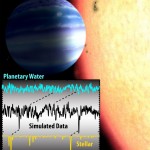W. M. Keck Observatory press release…
California Institute of Technology (Caltech) astronomers using data gathered at the W. M. Keck Observatory have developed a new technique for planetary scientists that could provide insight into how many water planets like Earth exist within our universe. The results have been published on February 24th by The Astrophysical Journal Letters.

Credit: Alexandra Lockwood (CalTech) background image used with permission from David Aguilar (CFA)
However, a significant portion of the population of extrasolar planets does not fit either of these criteria and there wasn’t really a way to find information about the atmospheres of these planets. Looking to resolve this problem, Lockwood and her advisor Geoffrey Blake—Caltech professor of cosmochemistry, planetary sciences and chemistry—were inspired by the recent detection of carbon monoxide in the extrasolar planet, tau Boo b and they wondered if they could detect water in a similar manner.
The method used to detect carbon monoxide utilized the radial velocity (RV) technique—a technique commonly used in the visible region of the spectrum, to which our eyes are sensitive—for discovering non-transiting exoplanets. Using the Doppler effect, RV detection traditionally determines the motion of a star due to the gravitational pull of a companion planet; the star moves opposite that of the orbital motion of the planet, and stellar features shift in wavelength. A large planet or a planet closer to its host star provides a larger shift.
The team used the carbon monoxide study as a guide to expand the RV technique into the infrared to determine the orbit of tau Boo b itself around its star, and added further analysis of the light shifts via spectroscopy—an analysis of the light’s spectrum. Since every molecule emits a different wavelength of light, this unique light signature allows the researchers to analyze molecules that comprise the planet’s atmosphere.
Using data of tau Boo b collected with the Near Infrared Echelle Spectrograph (NIRSPEC) instrument at the W. M. Keck Observatory in Hawai’i, the researchers were able to compare the molecular signature of water to the light spectrum emitted by the planet, confirming that the atmosphere did indeed include water vapor.
“The readout we get from Keck Observatory’s NIRSPEC is like listening to an orchestra performance; you hear all of the music together, but if you listen carefully, you can pick out a trumpet or a violin or a cello, and you know that those instruments are present,” Lockwood said. “The instrument allows you to pick out different pieces; like this wavelength of light means that there is sodium, or this one means that there’s water.”
In addition to using the spectrographic technique to study the planet’s atmospheric composition, the method also provides a way for researchers to analyze the mass of planets. “They’re actually two separate findings, but they’re both interesting,” Lockwood said. “When you’re doing calculations to look for the atmospheric signature—which tells you that there’s water present—you also determine the 3D movement of the star and the planet in the system. And with this 3D movement information, if you also know the mass of the star, you can determine the mass of the planet.”
Previous RV methods for measuring a planet’s mass could only determine the planet’s indicative mass—an estimation of its minimum mass, which might be much less than its actual mass. This new technique provides a way to measure the true mass of a planet since both light from the star and the planet are detected, which can provide more accurate insights about the planet’s formation and the evolution of its planetary system.
Although the technique promises to augment how planetary scientists analyze the properties of extrasolar planets, it has limitations, the researchers say. For example, the technique is presently limited to so-called “hot Jupiter” gas giant planets like tau Boo b—those that are large and orbit very close to their host star.
“The technique is limited by the light collecting power and wavelength range of the telescope, and even with the incredible collecting area of the Keck mirror on the high, dry summit of Mauna Kea we can basically only analyze hot planets that are orbiting bright stars. But, that could be expanded in the future as telescopes and infrared spectrographs improve,” Lockwood says. In addition to analyzing cooler planets and dimmer stars, the researchers plan to continue looking for and analyzing the abundance of other molecules that might be present in the atmosphere of tau Boo b.
“While the current state of the technique cannot detect Earths around stars like the Sun, with Keck Observatory it should soon be possible to study the atmospheres of the so-called `super-Earth’ planets being discovered around nearby low mass stars, many of which do not transit,” Blake said.
The findings were published in a paper titled “Near-IR Direct Detection of Water Vapor in tau Boo b.” Other coauthors include collaborators from Pennsylvania State University, the Naval Research Laboratory, the University of Arizona, and the Harvard-Smithsonian Center for Astrophysics. The work was funded by the National Science Foundation Graduate Research Fellowships Program, the David and Lucile Packard and Alfred P. Sloan Foundations, and the Center for Exoplanets and Habitable Worlds.

